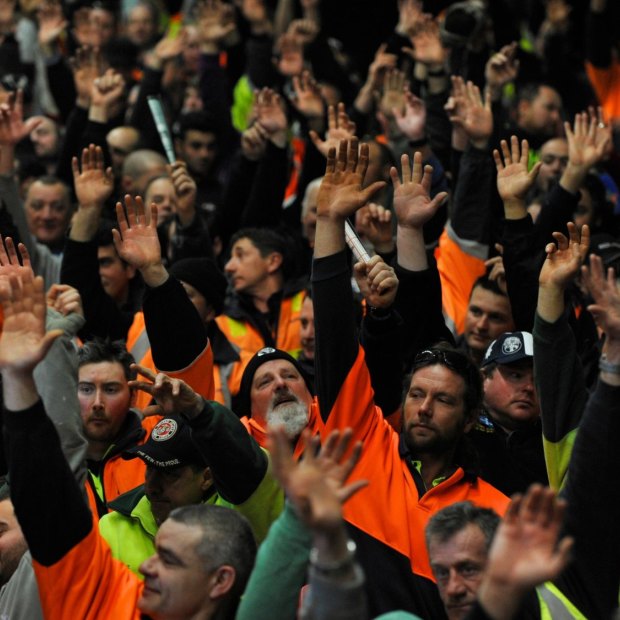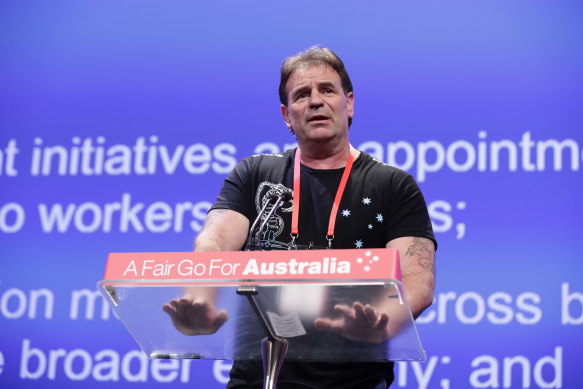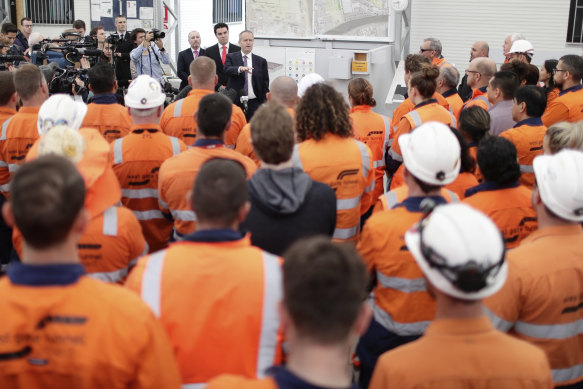God forgives, the CFMEU doesn’t: The warning for Labor after Setka
By Kieran Rooney and Rachel Eddie

CFMEU members vote at a meeting in 2011.Credit: Justin McManus
God forgives, the CFMEU doesn’t.
What was once a catchcry that struck fear into the hearts of major builders and a source of T-shirt revenue for the union is now a warning for the Australian Labor Party.
In 2019, CFMEU delegates staged a walkout at Victorian Labor’s state conference, part of a dispute between state secretary John Setka and then-opposition leader Anthony Albanese.
But in 2024, it was CFMEU “heavies” who stood at the doors as the party barricaded themselves in from pro-Palestinian protesters, holding them shut as Premier Jacinta Allan stood on the other side of the room.

Former CFMEU secretary John Setka at the Labor national conference in Adelaide in 2018.Credit: Alex Ellinghausen
Both these events, separated by five years, demonstrate how the CFMEU has been a double-edged sword within Labor. As a party that defines itself on its ability to collectivise, the union’s lone-wolf tendencies have chafed internally – but its working-class base has been impossible to ignore.
“Who will protect us and our children from socialists at the next conference?” one Labor figure quipped this week.
That relationship is now facing its greatest challenge since the union’s forerunner, the Builders Labourers Federation, was deregistered by Bob Hawke in 1986. The union will be suspended from the party and the Australian Council of Trade Unions, and put under administration following a week of explosive allegations in this masthead, the Australian Financial Review and 60 Minutes.
Although no one expects the CFMEU to be exiled forever, internally there are concerns the saga could scar the party for a generation.
“This union has an infamously long memory,” a party figure said.
The Age has spoken to a dozen union and party sources, speaking anonymously to avoid repercussions, to paint a picture of how the CFMEU operates within Labor. They describe a union that is so central to the party’s fortunes that it has been difficult to rein in its worst impulses.
Setka was elected as state secretary of the union in 2012 as it was locked in a long-running industrial war with Grocon in Victoria. After the Royal Commission into Trade Unions, Setka and deputy Shaun Reardon led the CFMEU into Labor’s Socialist Left faction, a grouping that Victorian Premier Jacinta Allan and Prime Minister Anthony Albanese both hail from.
But a broad church is not always a happy one. Setka deserted the faction in 2017 to help form a new grouping, the Industrial Left, alongside other blue-collar unions seeking greater influence in parliament.
The CFMEU’s resurgence was perfectly timed with the ramping up of the Victorian government’s Big Build agenda. Key projects such as the West Gate Tunnel and Metro Tunnel employed thousands of CFMEU members and their long-time rivals, the Australian Workers Union, making them vital to the party’s pitch for re-election.
Two union sources said disputes between the unions escalated when an enterprise agreement was signed for the Metro Tunnel in 2018. The CFMEU wasn’t happy with the deal and it sparked a six-year turf war to poach workers and replace companies on site that were either unaligned or linked to the AWU.
Electrical Trades Union state secretary Troy Gray, who has been an ally of Setka in the past, said in 2019 the controversial figure “could sign up half the membership of the AWU in Victoria without raising a sweat”.
Union delegates told this masthead that the West Gate Tunnel, infamously delayed over a toxic soil saga, was the frontline for the union’s disputes. They said attention then turned to the North East Link as early works began in 2020.

Then-opposition leader and former AWU boss Bill Shorten speaks with workers on the West Gate Tunnel during the 2019 election campaign.Credit: Alex Ellinghausen
“The bigger the project, the greater the disruption, the more likely it was the CFMEU would be there asking for agreements, picking out subcontractors or barring people from worksites,” one building company insider said.
The AWU is also a Labor-affiliated union, represented by three ministers in the Victorian cabinet, but sources said they have struggled to have their complaints acted upon on Spring St.
This year, state secretary Ronnie Hayden sent a letter to Transport Infrastructure Minister Danny Pearson, a member of the AWU, alleging workers were being targeted based on union affiliation and companies with lower bids were being overlooked.
Private companies and associations have also tried to petition the government for help.
When Indigenous firms complained of being pushed off the North East Link in 2023, Kinaway Chamber of Commerce told the Australian Financial Review they had sought help from the Andrews government only to be told there was nothing they could do.
It was a similar situation for Surveyors Australia, whose members play a critical role in construction that can severely delay projects.
The CFMEU began barring surveyors from sites in 2023 until they, and their companies, agreed to sign up to the union and their agreements. Professionals Australia urged its members not to give in, claiming the tactics were unlawful and would leave them worse off.
Surveyors Australia chief executive Michelle Blicavs said she had raised the issue with Allan who had always appeared “very interested” in their plight. But she said government agencies continue to palm the problem off onto other people.
“The then-deputy premier was very empathetic to our problem but couldn’t do anything,” Blicavs said.
Another construction industry source said for major builders, the sentiment from the government was that issues with the CFMEU should be resolved quickly and by themselves.
“The message was always if you can’t work with the CFMEU, you can’t deliver projects,” they said.
Another union source said the way the government and major contractors responded to CFMEU demands was akin to “giving a schoolyard bully your lunch money and hoping that will solve things”.
One government source said there was never any incentive to intervene. They said getting involved in a union turf war was politically poisonous and likely to cause further issues on projects fundamental to Labor’s mantra of “getting it done”.
Every time complaints went public, the government has always said it expected rigorous standards to be upheld on its sites. But ultimately, Allan has previously said in her years as transport infrastructure minister, “industrial relations matters are a matter for the construction industry and the employee representatives”.
That was no longer the case when Allan fronted the media on Monday.
In response to revelations in this masthead, she said she would commission a review of the power of government agencies to respond to these complaints. She asked the federal government to review enterprise agreements on major projects.
“I have absolutely zero tolerance for any sort of bullying thuggish intimidatory behaviour on Victorian work sites, and where we had had issues raised with either myself or the relevant delivery agency we have moved to immediately investigate those allegations,” she said.
Victorian Labor will also suspend the CFMEU from the party – a move that Labor insiders say will come with its own difficulties.
“Putting aside any donations, no union speaks to working-class members better,” one party insider said.
“Yes we have the ETU and the AMWU, but the CFMEU’s influence is wider and deeper.”
This appeal was visible ahead of the 2022 election, when the CFMEU was the only union to criticise Labor leader Daniel Andrews during the campaign.
“Dan might be a prick, but he’s a prick who’s delivering for construction workers,” a CFMEU ad read.
Labor and union sources said despite their differences, the CFMEU had always “come through” for Labor at elections. But they worried this was unlikely to continue after a week of being criticised publicly by state and federal ministers.
One Labor MP said the union’s working-class base was crucial in Melbourne’s north and west, where the party was trying to battle a perception that they do not receive a fair share of infrastructure funding.
Internally, the impact on Labor’s factional politics will depend on how long the union remains in administration and is suspended from the party. The Industrial Left grouping it is a part of has two MPs in state caucus – Luba Grigorovitch and Tom McIntosh.
If the union is allowed back in the party within 12 months they may still be able to field delegates at state conference, vote on party positions and have a role in preselections ahead of the 2026 state election.
But other Labor sources said a quick return was nearly impossible. They said neither Albanese nor Allan would welcome them back to the party before either of their elections.
Despite its influence in construction and its loyal membership base, the CFMEU has struggled to achieve influence in parliament through aligned MPs. Cracks emerged in 2017 as they began to feel under-represented compared to other major unions that wielded influence in the Left.
This came to a head when the late Jane Garrett, an Andrews government minister and close ally of the union, lost preselection for an upper house spot in Melbourne’s west through other factional deals.
Capitalising on this, Garrett brought the CFMEU and other blue-collar unions into a new faction and named it the Industrial Left. Former powerbroker Adem Somyurek brought right wing MPs together with this new political force to form an alliance large enough to dominate Victorian Labor.
Although this power-sharing arrangement was gutted in the fallout of an IBAC investigation into Somyurek, the Industrial Left remains. It is aligned with Labor Unity, a group of right-wing unions and MPs that does not include the AWU. The Socialist Left currently dominates Victorian Labor and the state caucus.
The CFMEU’s time in the Industrial Left has been the longest period in recent memory in which the union has stayed put in a single faction. Its influence was expected to grow as it sought further representation. In April, Setka laid out a plan to sign 1000 union members up to the ALP so the union could have a greater say on how the party was run.
For now, that ambition will have to wait. Across the Labor Party, opinions differ on how long the CFMEU fallout will last, but they all agree on one thing.
“They will be back.”
Get the day’s breaking news, entertainment ideas and a long read to enjoy. Sign up to receive our Evening Edition newsletter here.